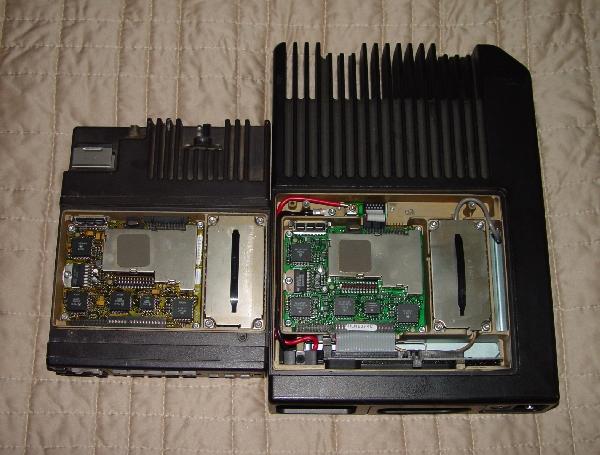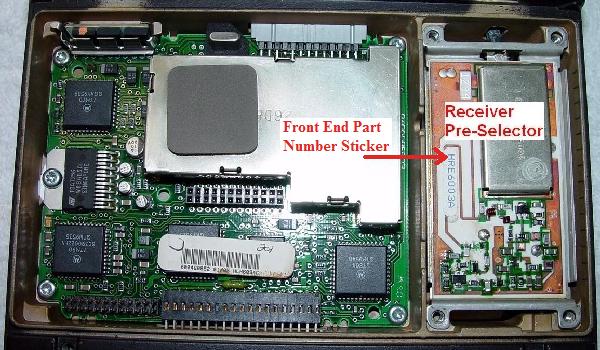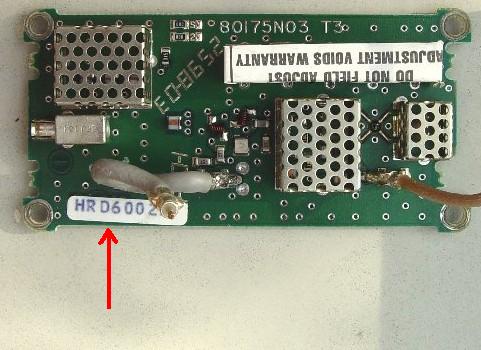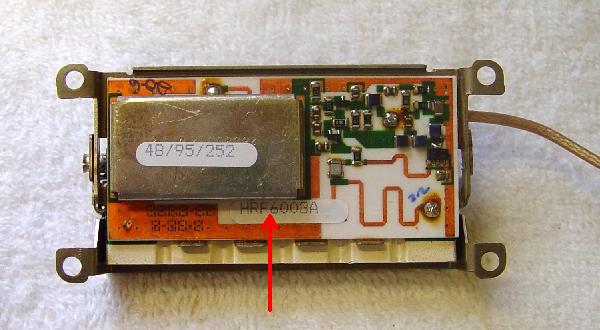Motorola Index
Back to Home
By Mike Morris WA6ILQ
Photos are courtesy of Bob Meister WA1MIK

|
Spectra Index Motorola Index Back to Home |
How to Determine the Range or Split of your Spectra Radio By Mike Morris WA6ILQ Photos are courtesy of Bob Meister WA1MIK |

|
The Motorola Spectra series were made in several frequency bandsplits, called ranges, or splits. You can't figure out what you have unless you read the radio, or lift the cover and look at a frequency-determining part. And sometimes when you read a new-to-you radio, it lies, because someone forced a wrong-range code plug into it. Or maybe someone sold you a Frankenstein radio (i.e. built from spare parts).
The quickest way to determine what you have is to look at the receiver preselector, usually called the front end or RXFE.
Let's start with the basic radio, with the top cover off. A mid power
radio package is on the left in the photo below (the low power package is
the same except for a shorter heat sink), and a high power radio is on the
right. The particular mid power radio in the photo happens to be a front
mount version, with an integrated control head; all high power radios were
remote mount (trunk mount).
The silver rectangle with the black stripe on the right side of the radio
is a shield cover over the front end. The black stripe is a plastic handle
that is used to remove the cover. Remove the four T15 screws in the corners,
slide your finger under the handle and pull it straight up and off.

The assembly number sticker could be located on the top or bottom of the
module; it's wherever Motorola found the room to place it. Some radios have
the sticker on the top of the front end module (on this UHF radio it's marked
HRE6003A). If you look that number up in the tables below, you will find that
the number translates to a 450-482 MHz non-preamp front end. Now you know the
frequency range of the front end (and hopefully your entire radio; no guarantees
here).

This photo of a VHF front end shows the sticker on the bottom of the module.
You will need to unplug the input coax from the rear of the module, then you
will find a push-in cable protruding out of the underside of the board which
also has to be unplugged. Be careful as you remove or reinsert the module and
its cables.

The 800 and 900 MHz front ends are identical except for the ceramic filter.
This 900 MHz front end has the label on the top.

Below is a list of the VHF and UHF ranges that we know of. All front end part numbers have a letter suffix indicating the revision: A, B, C, etc.
| VHF Splits | |||
|---|---|---|---|
| Board Range | Frequency Range | Non-Preamp | With Preamp |
| 1 | 136-162 MHz | HRD6001 | HRD6011 |
| 2 | 146-174 MHz | HRD6002 | HRD6012 |
| UHF Splits | |||
|---|---|---|---|
| Board Range | Frequency Range | Non-Preamp | With Preamp |
| 1 | 403-433 MHz | HRE6001 | HRE6011 |
| 2 | 438-470 MHz | HRE6002 | HRE6012 |
| 3 | 450-482 MHz | HRE6003 | HRE6013 |
| 4 | 482-512 MHz | HRE6004 | HRE6014 |
The 800 MHz radios came in one split that covered 851-869 MHz. The front end is part number HRF6004 and there was no preamp option.
The 900 MHz radios came in one split that covered 935-941 MHz. The front end is part number HRF6003 and there was no preamp option.
Acknowledgements and Credits:
The front end assembly numbers came from a Spectra manual. The HRE6003BSP01 part number was provided by a city two-way tech, and he reports that despite the "SP" part number this unit is not rare - his entire city police department fleet uses Astro-Spectra radios in that range (and the Spectra and Astro Spectra radios RF sections are very very similar).
Contact Information:
The author can be contacted at: his-callsign // at // repeater-builder // dot // com.
Back to the top of the page
Spectra Index
Motorola Index
Back to Home
This page originally posted on 29-Jul-2009
Article text, artistic layout and hand-coded HTML © Copyright
2009 and date of last update by Mike Morris WA6ILQ.
All photographs © Copyright 2009 by Robert Meister WA1MIK.
This web page, this web site, the information presented in and on its pages and in these modifications and conversions is © Copyrighted 1995 and (date of last update) by Kevin Custer W3KKC and multiple originating authors. All Rights Reserved, including that of paper and web publication elsewhere.